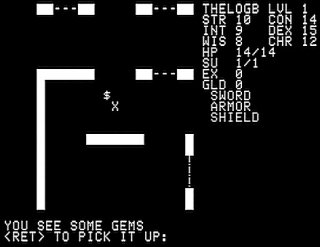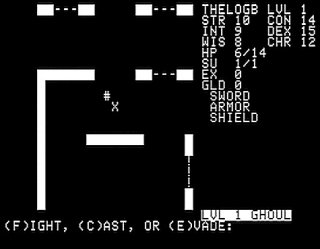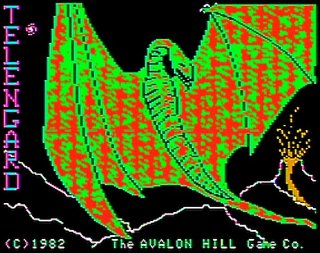 The Game: Using primitive text-based graphics, Telengard books for you a no-expenses-paid vacation through dungeons and hallways full of orcs and other nasties. If you can map the twisty passages, you might just make it back to the Adventurers’ Inn to claim your newfound experience points and heal from your many battles…and if you get lost? There are other inns out there – and many painful ends as well. (Avalon Hill, 1982)
The Game: Using primitive text-based graphics, Telengard books for you a no-expenses-paid vacation through dungeons and hallways full of orcs and other nasties. If you can map the twisty passages, you might just make it back to the Adventurers’ Inn to claim your newfound experience points and heal from your many battles…and if you get lost? There are other inns out there – and many painful ends as well. (Avalon Hill, 1982)
Memories: Telengard was my introduction to computer-based adventure RPGs. I was already one foot into the Dungeons & Dragons world at the time, though truthfully some of the people I played those pencil-and-paper-and-dice RPGs with scared me. Some of them – not all of them, by any means, but a few – tackled these games with enough intensity to make a kid nervous.
 So when something closely approximating that experience became available for my Apple, I was hooked. That addiction led to Zork I, and that addiction dovetailed into my obsession with the Ultima games… the rest, as they say is history.
So when something closely approximating that experience became available for my Apple, I was hooked. That addiction led to Zork I, and that addiction dovetailed into my obsession with the Ultima games… the rest, as they say is history.
Telengard suffered somewhat from its cryptic command structure, which I later came to believe was made indecipherable so software pirates – who didn’t have the benefit of the docs – would be unable to play the game. Hell, I bought the game and had the docs, and it still baffled me at times.
 But that didn’t stop me from playing. A lot.
But that didn’t stop me from playing. A lot.
Sadly, computer RPGs haven’t remained as relatively simple as Telengard and the  first five Ultima titles. They’ve grown into something much more elaborate and involved and intense.
first five Ultima titles. They’ve grown into something much more elaborate and involved and intense.
Enough intensity, one might say, to make a kid like me nervous.
